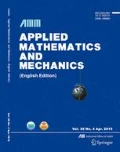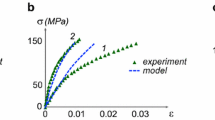Abstract
Experimental observations show that quasi-isotropic materials, such as N-axial fibre-reinforced composites and woven materials, exhibit various degrees of anisotropy in elasticity and strength, and the anisotropy in strength is normally stronger than that in elasticity. In view of some available experimental data and based on the general formulation of the constitutive equations and failure criteria of quasi-isotropic materials established by using the theory of representations for tensor functions, we postulate several applicable models of the constitutive equations and strength for 3-and 4-axial quasi-isotropic materials to reveal the anisotropic effects. In a continued work (Part II), the anisotropic effect in strength of an infinitely large plate with a single elliptical hole or crack is studied, and the proposed stiffness and strength models are verified in terms of micro-mechanical analyses.
Similar content being viewed by others
References
S. W. Tsai and H. T. Hahn, Introduction to Composite Materials, Tech. Pub. Co., Inc.
Z.-M. Wang, Strength and Structural Mechanics of Composites, Mechanical Engineering Pub., Beijing (1980). (in Chinese)
F. Zhou and F.-Q. Fan, Mechanics of Composite Materials, High Education Pub., Beijing (1991). (in Chinese)
Z.-D. Luo and Z.-M. Wang (eds.), Advances in Mechanics of Composite Materials, Peking Univ. Press (1991). (in Chinese)
F. Weiren and C. B. Norris, Mechanical properties of a laminate designed to be isotropic, Report No. 841, Forest Products Laboratory, Forest Service, US Department of Agriculture (1953).
Q.-S. Zheng, J. Betten and A. J. M. Spencer, The formulation of constitutive equations for fibre-reinforced composites in plane problems: Part I, Arch. Appl. Mech., 62 (1992), 530–543.
Q.-S. Zheng and J. Betten, The formulation of constitutive equations for fibre-reinforced composites in plane problems: Part II, Arch. Appl. Mech., 65 (1995), 161–177.
R. M. Jones, Mechanics of Composite Materials, Scripta Book Company, Washington, DC (1975).
K. M. Wu, Isotropic composite plates, research report EM-429, General Motors Research Lafboratories, Warren, Michigan (1979).
T. W. Chou and F. K. Ko, Textile Structural Composites, Elsevier Science Publishing Company, Inc. (1989), 357–365.
A. Fujita, H. Humada and Z. Maekawa, Tensile properties of carbon fibre triaxial woven fabric composites, Journal of Composite Materials, 27 (1973), 1428–1442.
Q.-S. Zheng, Yielding and failure of quasi-isotropic composites, in Advances in Engineering Plasticity and Its Applications (B. Y. Xu and W. Yang, eds), Int. Academic Pub., Beijing (1994), 137–142.
Q.-S. Zheng, Theory of representations for tensor functions—A unified invariant approach to constitutive equations, Appl. Mech. Rev., 47 (1994), 544–587.
S. W. Tsai, A survey of macroscopic failure criteria for composite materials, J. of Reinforced Plastics and Composites, 3 (1986), 40–62.
Author information
Authors and Affiliations
Additional information
Project supported by the National Natural Science Foundation of China and the State Education Commission Foundation of China
Rights and permissions
About this article
Cite this article
Quanshui, Z., Huiyu, F. Anisotropic effects of quasi-isotropic composites (I) — Modelling. Appl Math Mech 17, 923–931 (1996). https://doi.org/10.1007/BF00147129
Received:
Issue Date:
DOI: https://doi.org/10.1007/BF00147129




